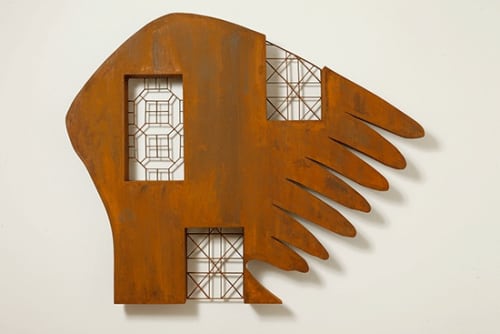The exhibition Split Distance brings together Rajendran’s recent series of sculptures and drawings where he explores ideas of space and materiality. Working with materials like laminates, wood, iron lattice works (jalis) , and glass, he builds bold assemblages that bring into focus the endurance of these materials in our domestic lives, and marks the fragility of the domain of the private that is enclosed and demarcated by such material. For instance, metal grill windows puncture a solid iron surface shaped like a wing, acting as a metaphor between the inside and the outside, and the illusion of freedom and mobility that such a motif offers. The title Split Distance is in a way a reference to this physiological/mental/political distance that is created through physical means like boundaries, fences, architectures etc. The critical commentary on cities and displacements set in engaging juxtapositions and conversations is a tread he carries forward from his earlier works, and has remained integral to Rajendran’s artistic language for a while. Dilemmas of displacement, migration and hyper-urbanization are issues that he brings into focus yet again in this show.
The reference to architecture is unmistakable in Rajendran’s work, with even his drawings suggesting monumentality that defies its own scale, as he strips it off its formality and constructs ways to experience it through personal prisms of mobility, movement and status. Spatiality, and his ability to amplify the emptiness around his sculptures and bind it into the viewer’s experience, is distinctive to his practice and very significant when looking at it in today’s context of immersive viewing. His mastery over the material is again quite evident in his new set of works - executed with finesse, he manages to giving his materials an expressive versatility which stands in contrast to the brittle and sterile nature of the material itself. Described as ‘sculptural composites’ (Ranjit Hoskote, The Cautioner's Tales, 2008) for the permutation of industrial materials like iron, stainless steel, tiles, concrete and leather, each work of Rajendran’s demonstrate his labour over understanding material and their significance to the practice of sculpture-making.
